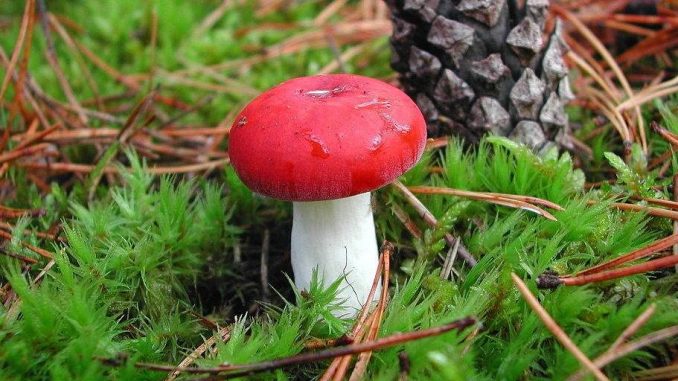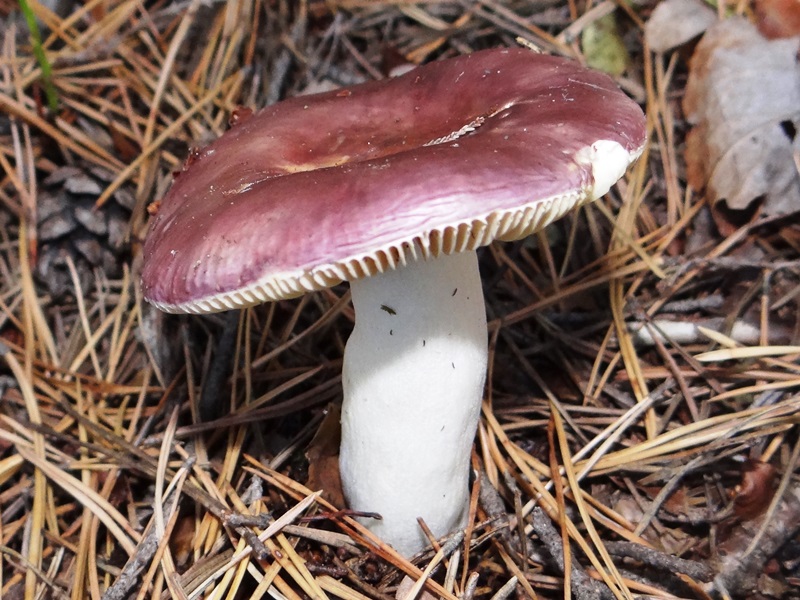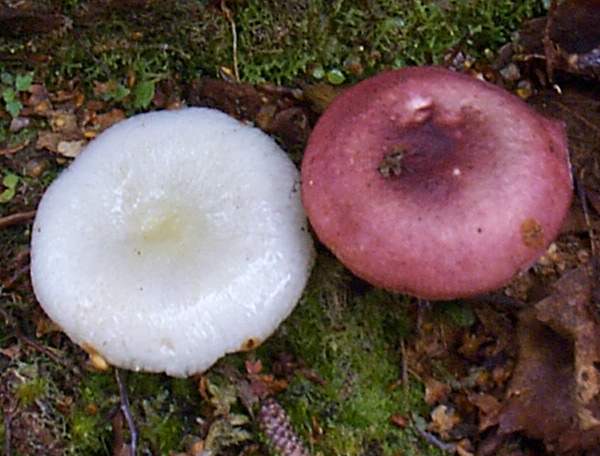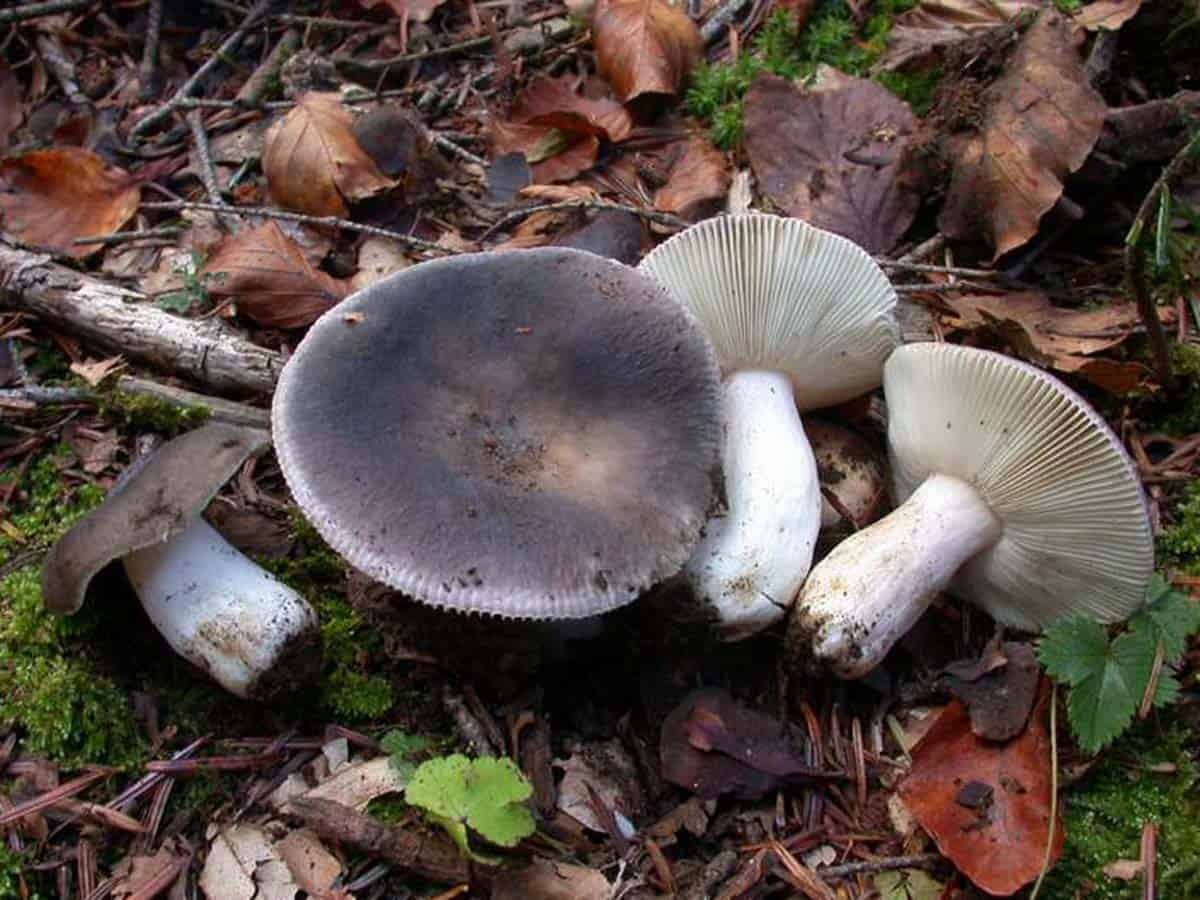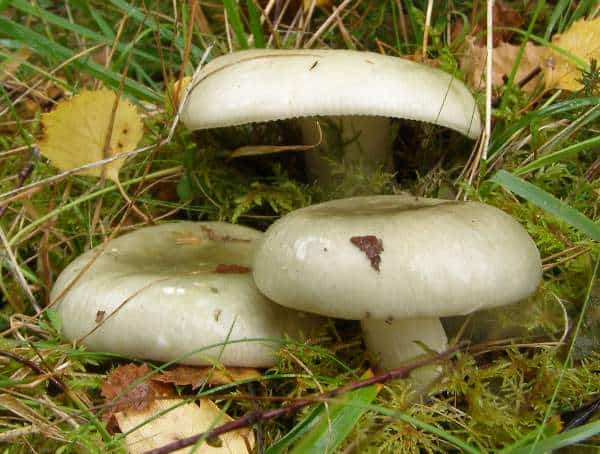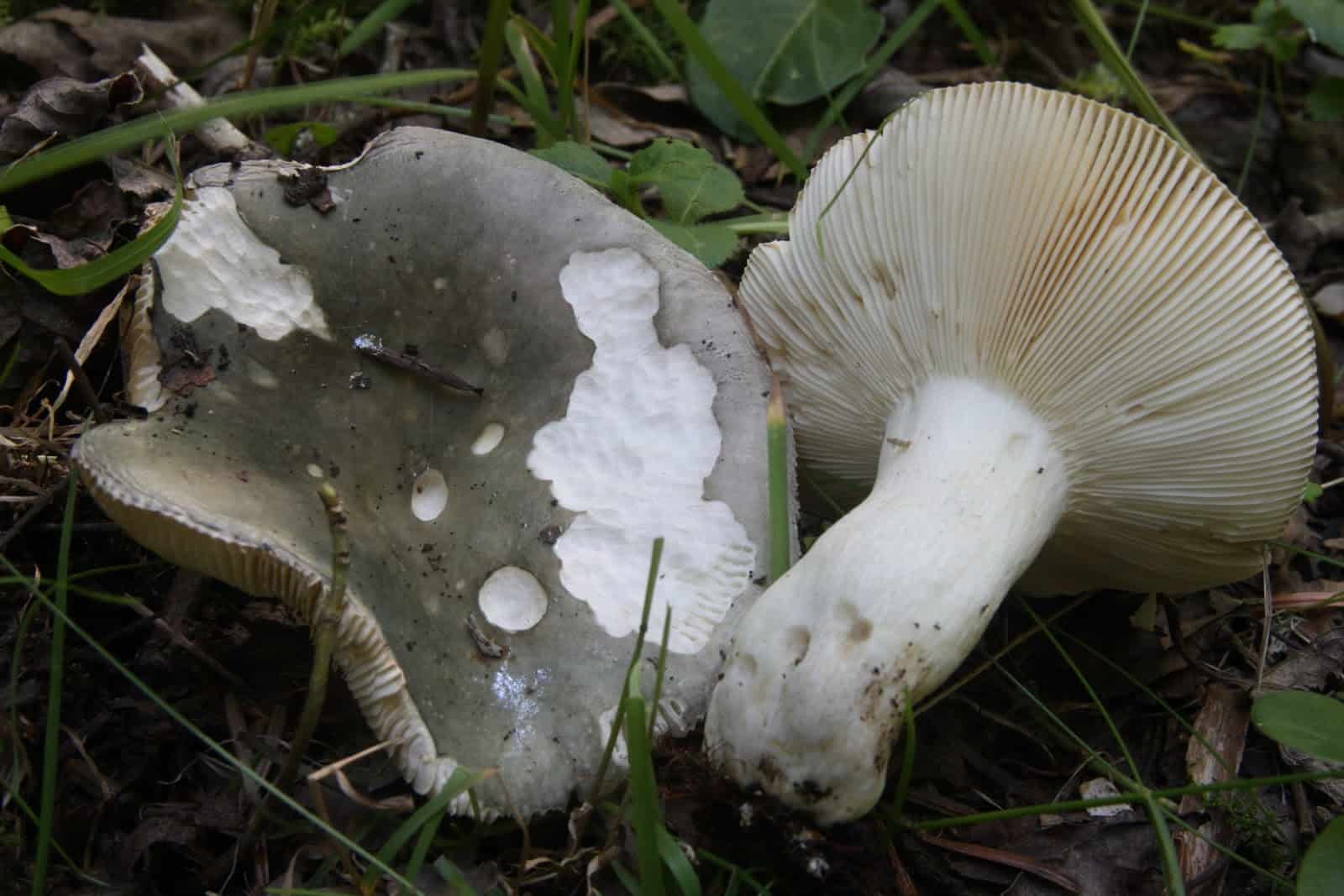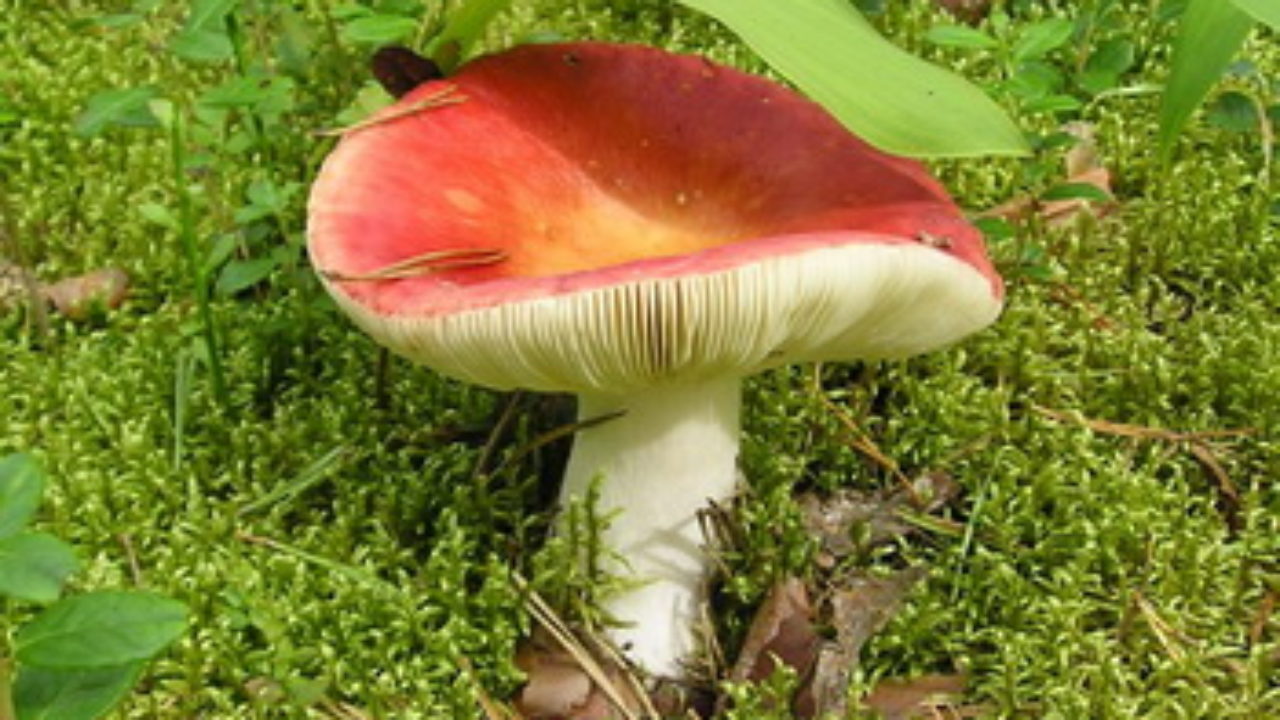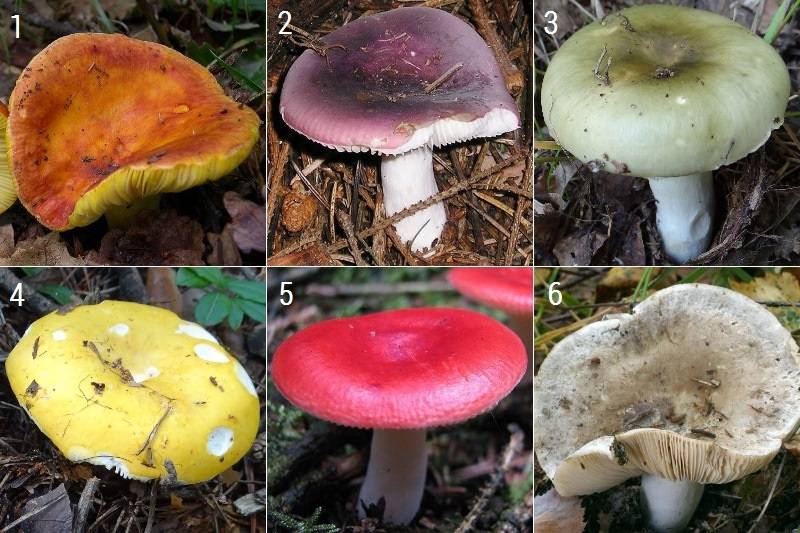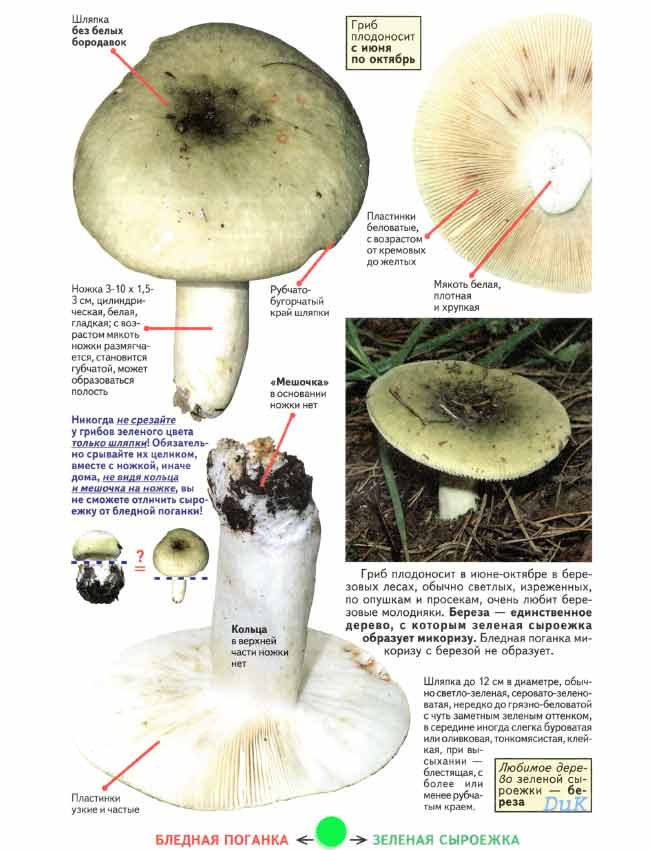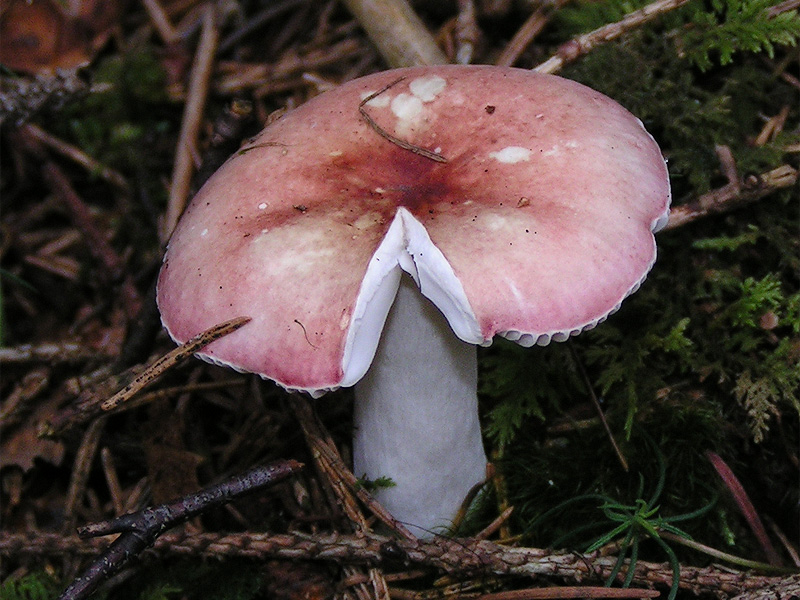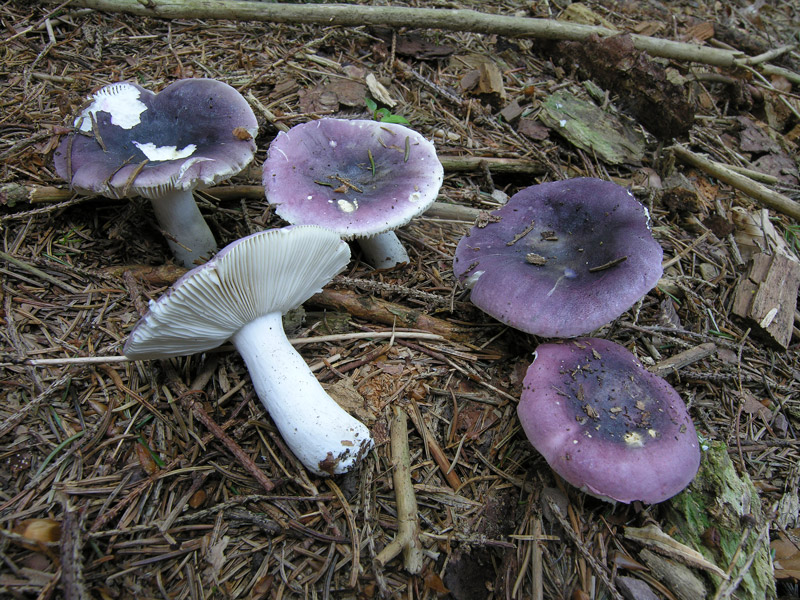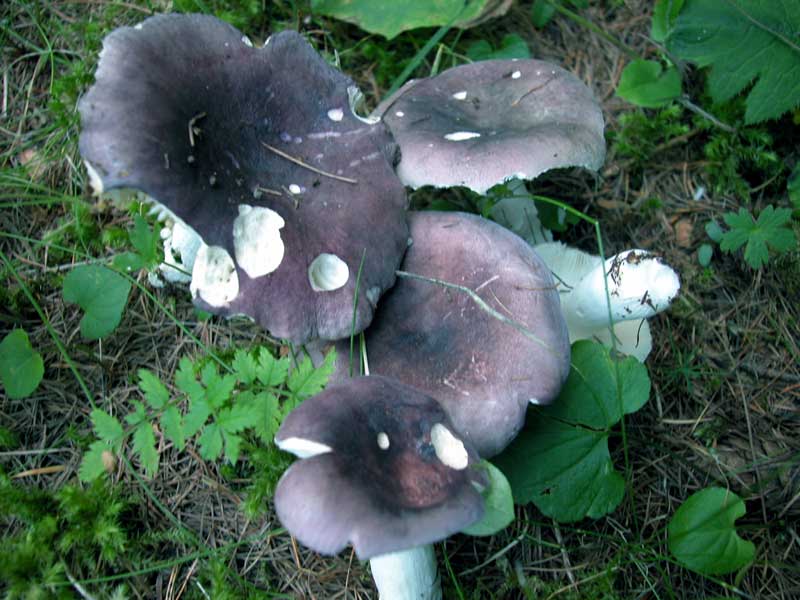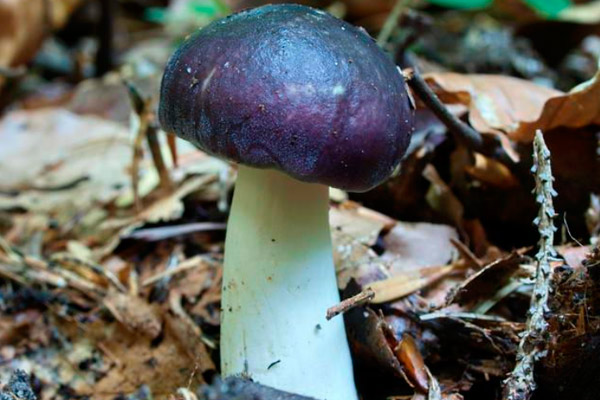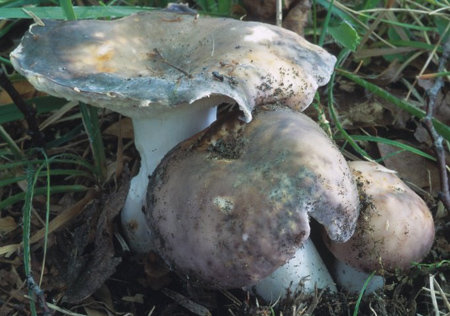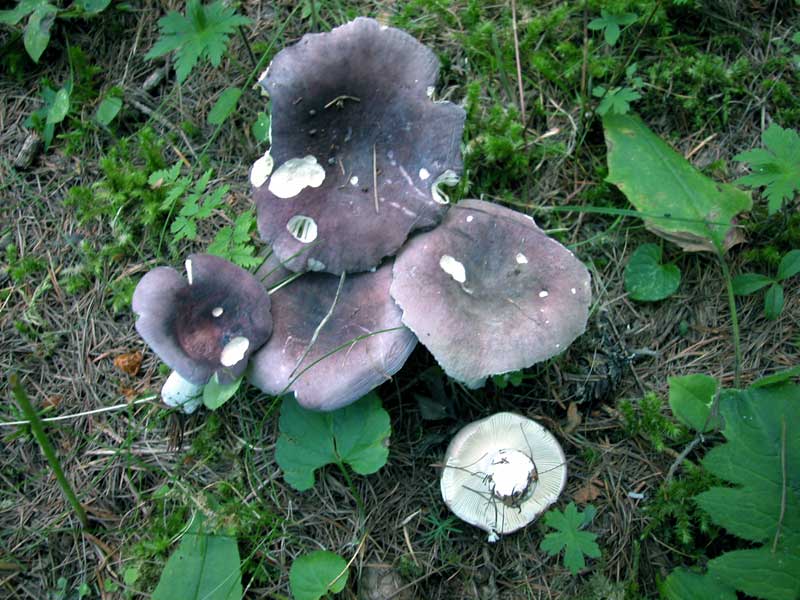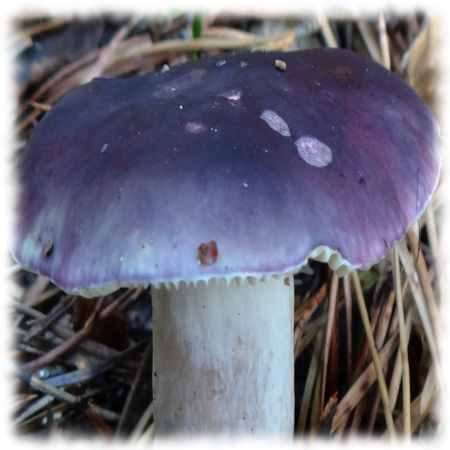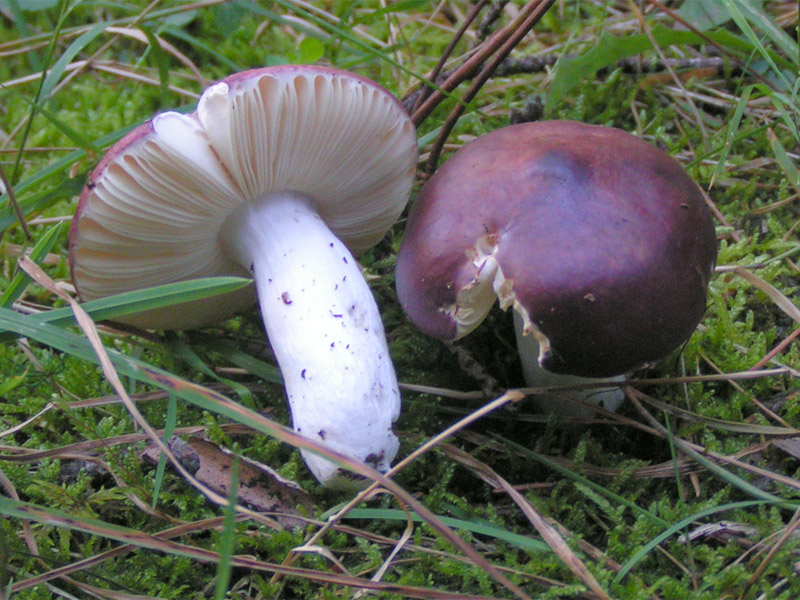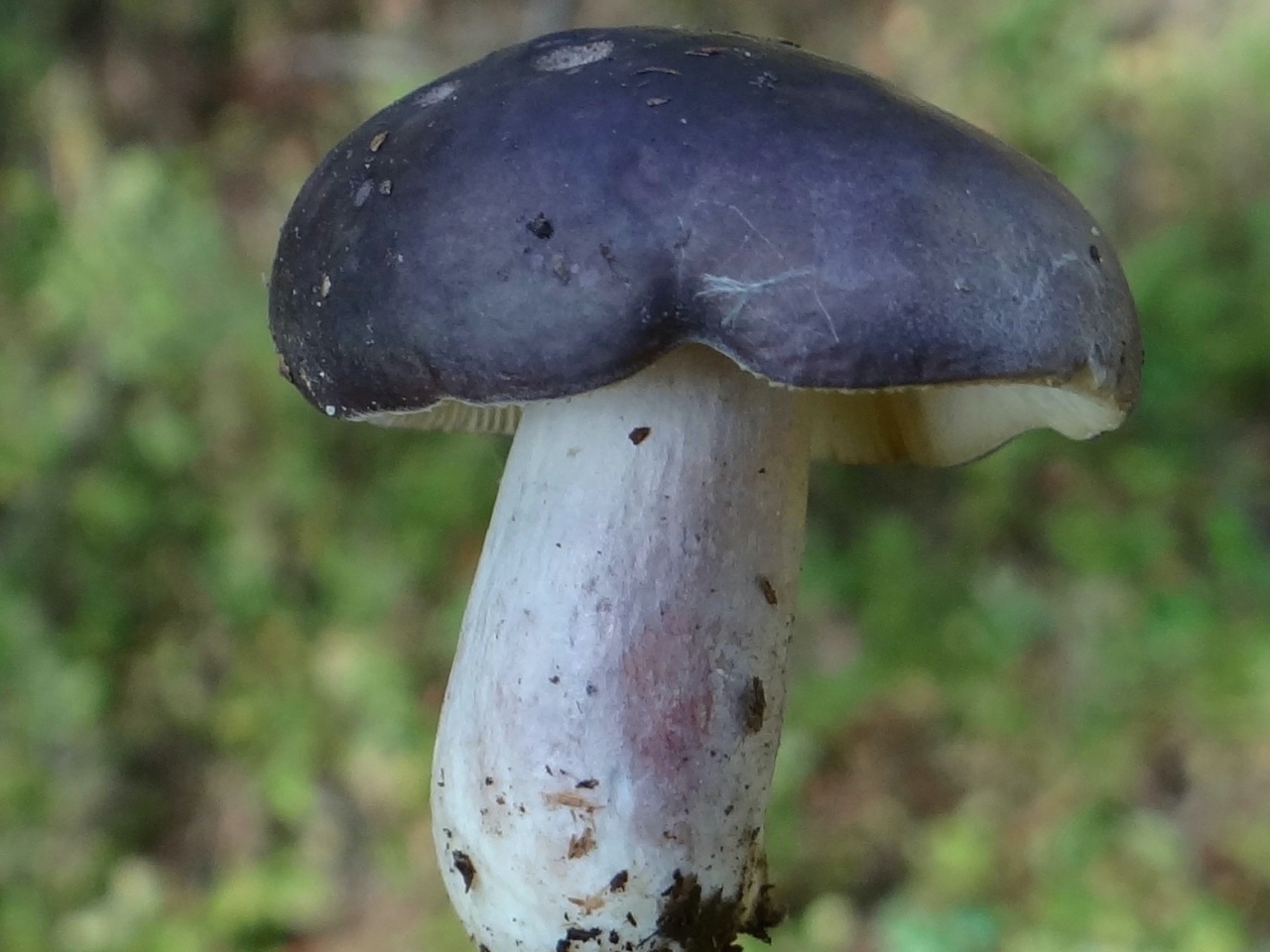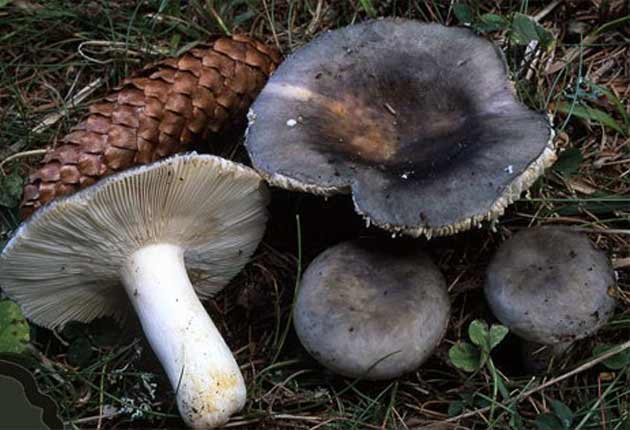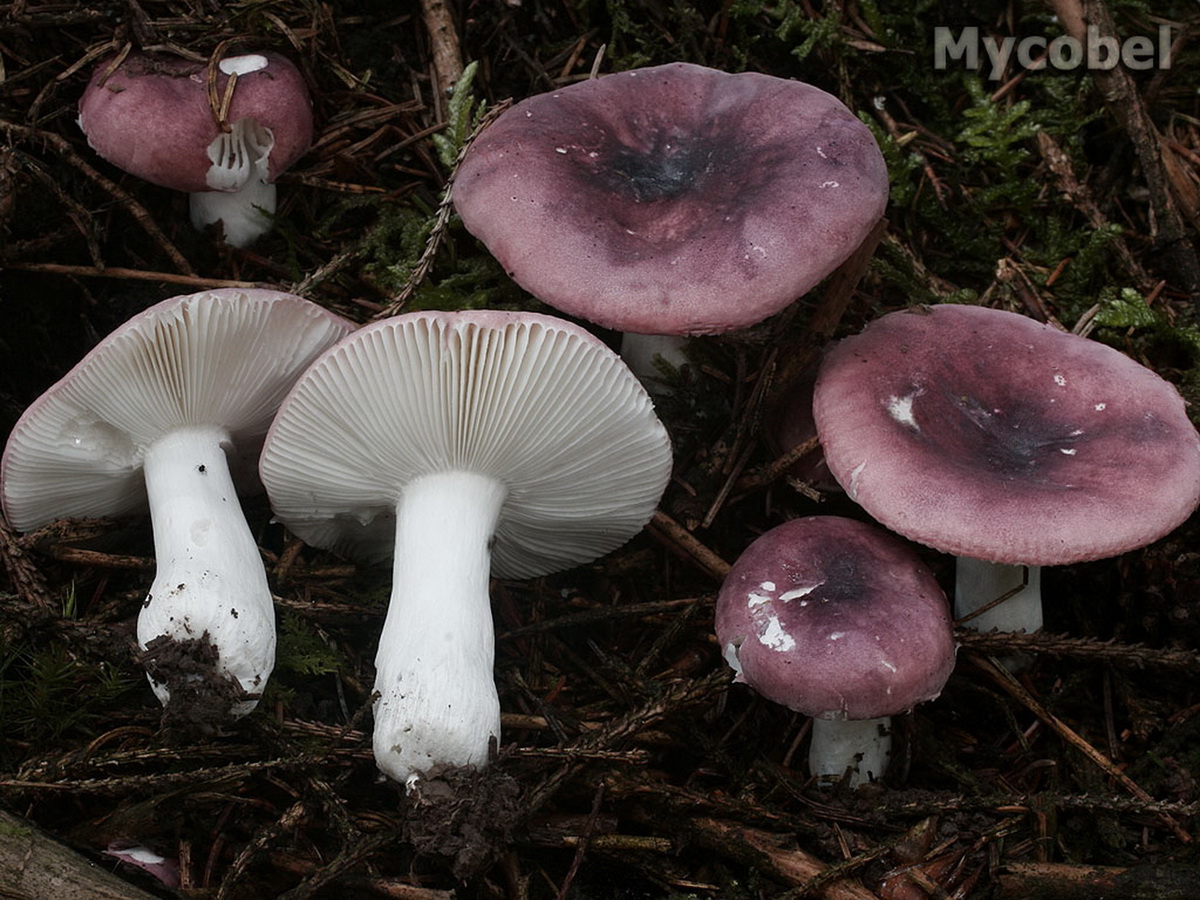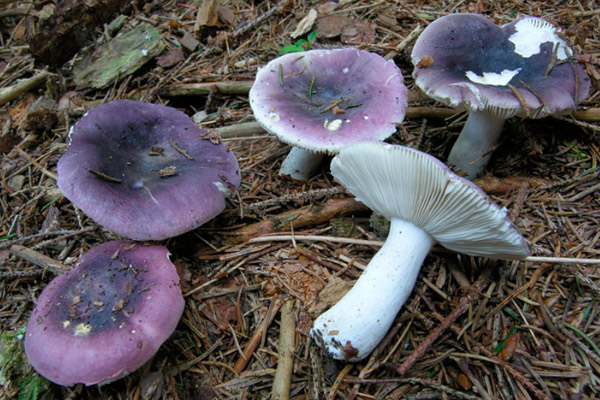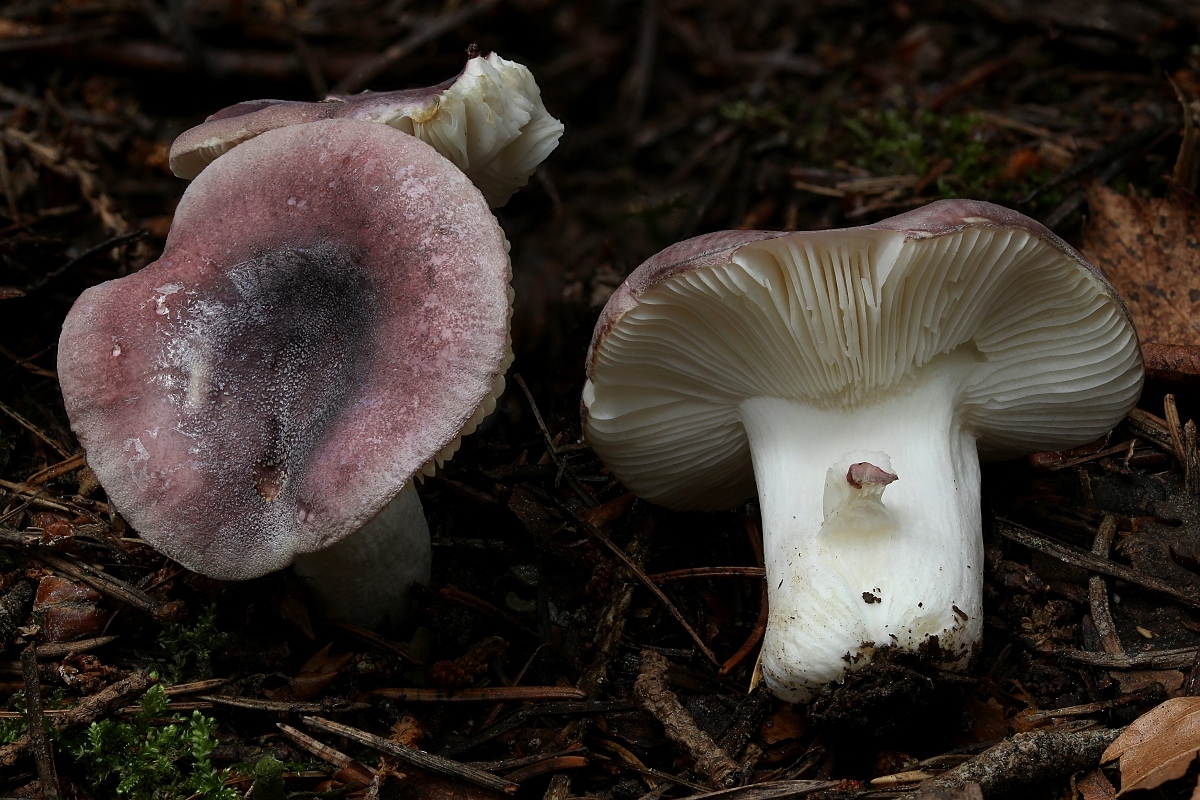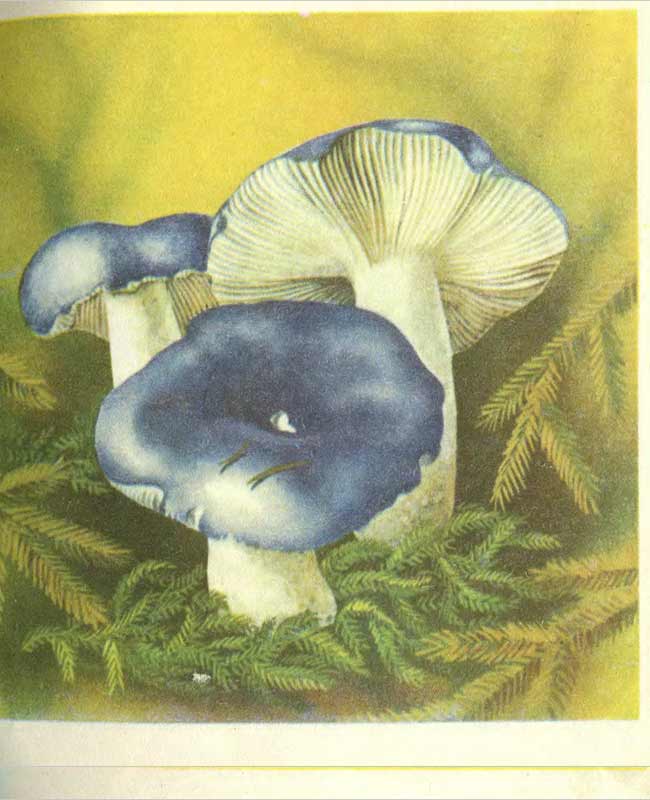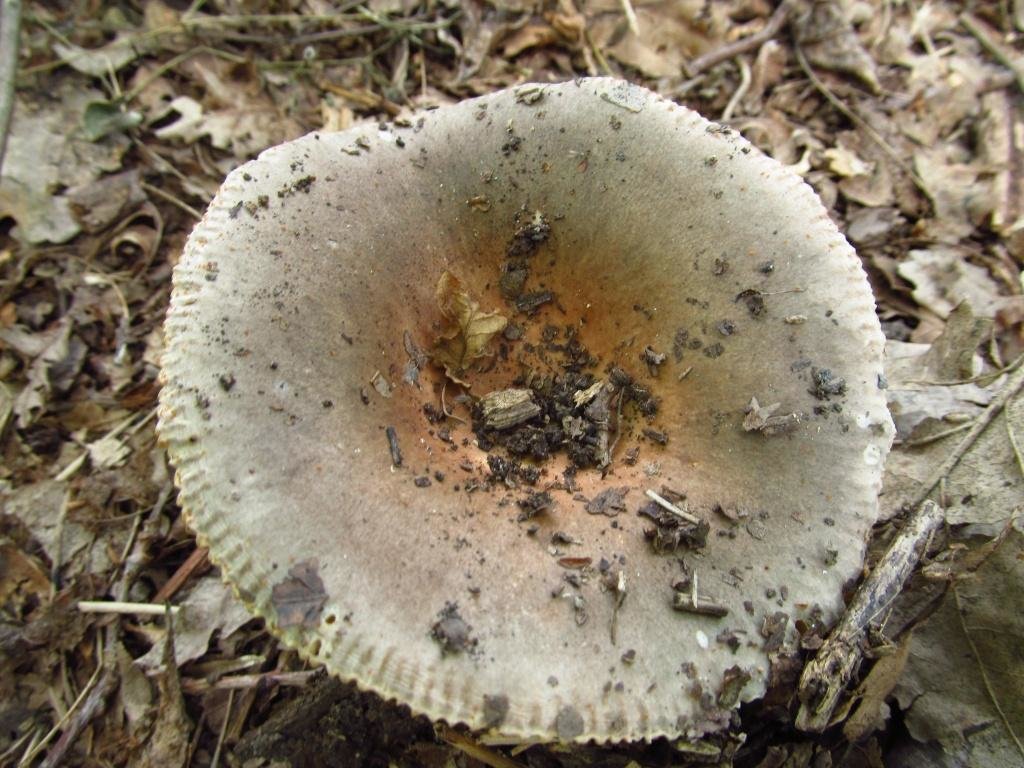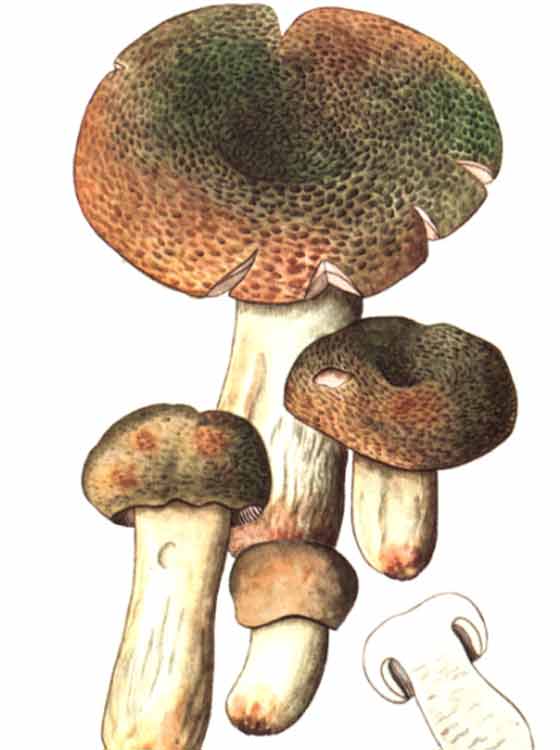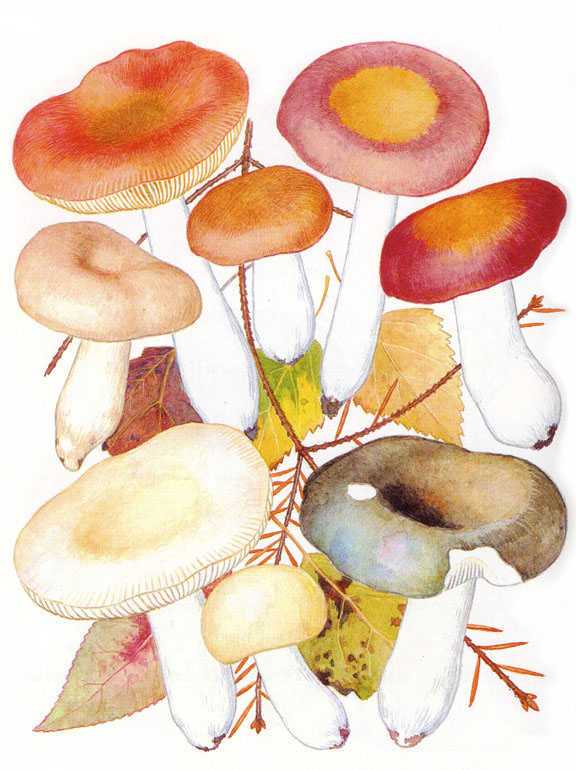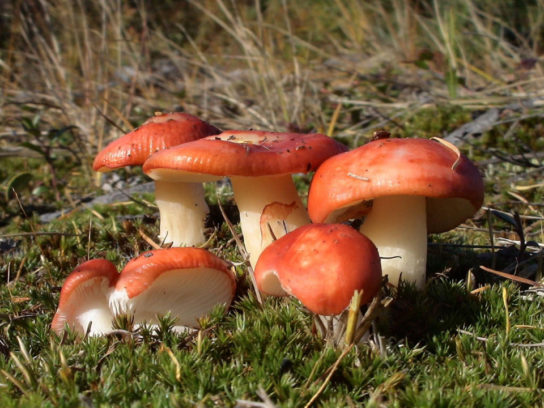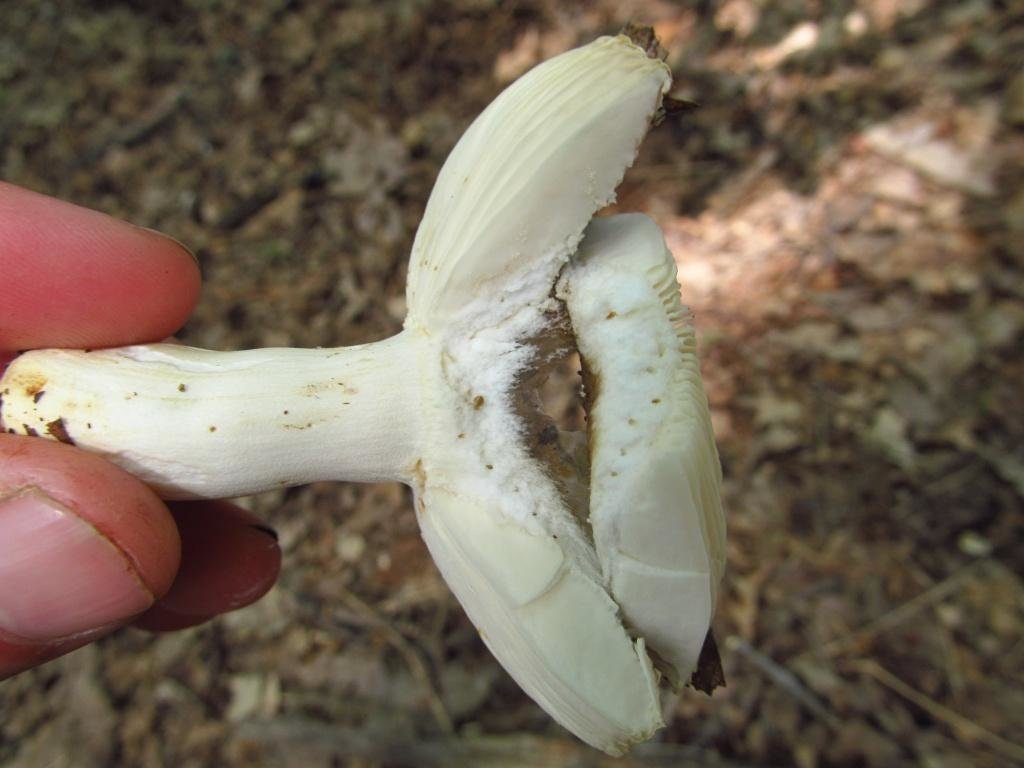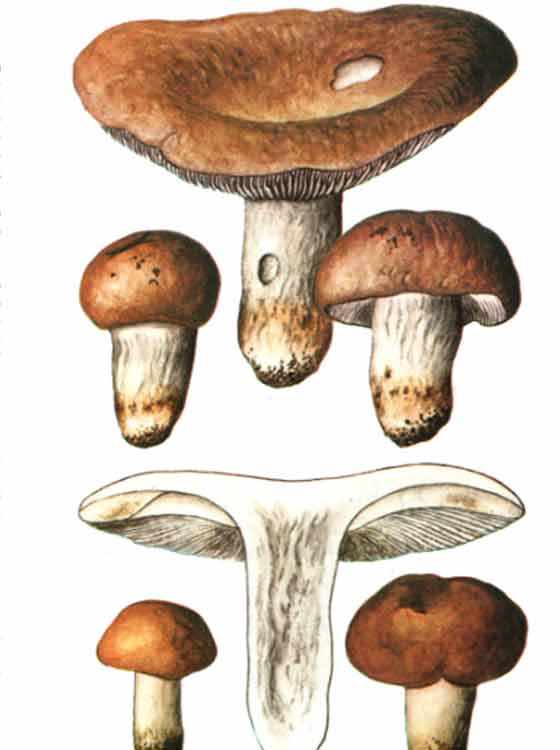Why can you get poisoned?

The russula mushroom, which is edible, may well be eaten without cooking. However, it should not be eaten completely raw. You can, for example, fry, pickle or pickle. If there are doubts and worries about a particular mushroom, it is recommended to either cook (stew) or completely refuse to use it. How much russula to cook to be safe to consume? The answer is simple. It is necessary to cook in two waters: first bring to a boil in one container, then transfer to new boiling water and cook there for about 20 minutes. If, nevertheless, after consumption there are signs of food poisoning (nausea, vomiting, diarrhea), it is recommended to cleanse the stomach and intestines of food debris with vomiting and enemas, to take enterosorbents. But if you feel the need, consult a doctor.
Russula fading
| Group: | Lamellar |
|---|---|
| Plates: | White |
| Colour: | Crimson |
| Info: | On the cut turns red |
| Department: | Basidiomycota (Basidiomycetes) |
|---|---|
| Subdivision: | Agaricomycotina (Agaricomycetes) |
| Class: | Agaricomycetes (Agaricomycetes) |
| Subclass: | Incertae sedis (indefinite) |
| Order: | Russulales |
| Family: | Russulaceae (russula) |
| Genus: | Russula (Russula) |
| View: | Russula exalbicans (russula, fading) |
Description
The beautiful russula is characterized by a bright color of the cap, which "fades" over time, hence the name of the species.
Hat
Fading russula caps are usually small (up to 10 cm in diameter), but there are extremely large overripe specimens. The color is usually close to crimson, with darker edges. Enlightenment can be observed in the center. Small russules have spherical, gradually opening caps. The surface of the cap is dry and smooth. With the maturation of the mushroom and an increase in its size, the color of the cap turns pale. The skin is difficult to separate from the cap.
Leg
The leg of a beautiful russula is relatively thick and low (about 3 cm in thickness and 6 cm in length). It is cylindrical in shape with a downward extension. Its color is predominantly white with a pinkish tinge in the upper third. In the lower third, yellow spots may appear.
Pulp
In young specimens, the flesh is white, and in old specimens it is grayish, it turns red on the cut, then turns gray. The consistency is dense, tough, especially at the legs, so many people prefer to eat only hats. The raw mushroom tastes bitter, but when cooked it is sweetish.
Distribution and collection
The beautiful russula is widespread almost all over the world, but prefers temperate latitudes. Symbiotic coexistence is usually found in russules fading with deciduous trees. But the growth of this species is also possible in coniferous forests.
Similar species
The fading russula has a rather characteristic appearance so as not to be confused with other mushrooms. The only mushroom that looks a little like her is the russula, burning or emetic.
The latter is distinguished by whiter plates (not darkening in mature mushrooms) and pulp that does not gray out on the cut. This mushroom has a very bitter taste, therefore it is considered inedible.
Its use can cause stomach troubles, which reflects its name. However, according to some sources, russula emetic becomes edible when boiled well.
Edibility
The beautiful russula has, according to many consumers, very mediocre taste. The legs of these mushrooms are rarely eaten because of their rigidity. We can say that russula is an amateur mushroom, suitable for those who prefer a strong food consistency. After boiling, russula are fried with potatoes, salted and pickled.
Interesting facts
Russula mushrooms, including such as the fading russula, are characterized by a number of interesting properties:
- Russulin contained in russula promotes milk curdling, therefore russula components can be used in cheese making.
- Lecithin, which is part of this mushroom, lowers the content of bad cholesterol in the blood.
- Regular use of russula cleanses the gastrointestinal tract.
- The russula got its name not because it can be eaten raw. Quite the opposite: like any conditionally edible mushroom, it requires preliminary digestion.
And the name comes from the fact that pickles from these mushrooms are prepared faster than from the rest.
Not all mushroom pickers collect russules. Many neglect them, because there are boletus, moss and other, more "valuable" mushrooms. However, fried or salted russula are also quite edible and tasty.
Kele's russula (Russula queletii)
Synonyms:
- Russula sardonia f. queletii
- Russula flavovirens
Kele's russula is considered one of the few russules that can be easily identified by the combination of the following features:
- the predominance of purple flowers in the color of the cap and legs
- growing near conifers
- off-white spore print
- acrid taste
Ecology
Forms mycorrhiza with conifers, especially spruce and some types of pines (two-needled pines). Curiously, the European Kele russula is considered to be more tied to spruce trees, while the North American ones come in two "versions", some associated with spruce and others associated with pines.
Description
Hat: 4-8, up to 10 centimeters. In youth, fleshy, semicircular, convex, later - flat-convex, with age, prostrate, depressed-prostrate. In very old specimens, the edge is wrapped up. Sticky, sticky in young mushrooms or in wet weather. The skin of the cap is smooth, shiny.
The color of the cap in young specimens is dark blackish-purple, then becomes dark purple or brownish-violet, cherry-violet, purple, purple-brownish, sometimes greenish tints may be present, especially at the edges.
Plates: widely accreted, thin, white, with age, acquire a creamy, later - yellowish color.
Leg: 3-8 centimeters long and 1-2 centimeters thick. Color from pale purple to deep purple or pinkish purple. The base of the stem can sometimes be colored in shades of yellow.
Smooth or slightly pubescent, matte. Dense, fleshy, whole. With age, voids form, the pulp becomes brittle.
Flesh: white, firm, dryish, brittle with age. Under the skin of the cap - purple. Almost does not change color on cut and when damaged (it may turn yellow quite a bit).
Spore powder: from white to cream. Spores: ellipsoidal, 7-10 * 6-9 microns, warty. Chemical reactions: KOH on the surface of the cap gives a reddish-orange color. Iron salts on the surface of the leg: pale pink.
Smell: pleasant, almost indistinguishable. Sometimes it can seem sweetish, sometimes fruity or sour.
Taste: acrid, spicy. Unpleasant.
Season and distribution
Grows singly or in small groups in coniferous and mixed forests (with spruce).
Occurs from mid-summer to late autumn. Different sources indicate different ranges: July - September, August - September, September - October.
Widespread in the Northern Hemisphere (possibly in the Southern).
Edibility
Most sources classify the mushroom as inedible due to its unpleasant, pungent, pungent taste.
The mushroom is probably not poisonous. Therefore, those who wish can experiment.
Perhaps soaking before salting helps to get rid of the acridity.
One thing is clear: when conducting experiments, it is advisable not to mix Kele's russula with other mushrooms. So that you do not feel sorry if you have to throw it away.
Other information:
It's funny that different sources describe so differently which part of the cap is easily peeled off. So, for example, there is a mention that it is a "russula with a non-peeling skin."There is information that the skin can be easily removed in half or even 2/3 of the diameter. Whether it depends on the age of the mushroom, on the weather, or on the growing condition is unclear. One thing is clear: this russula should not be identified on the basis of “peelable skin”. As, however, and all other types of russula.
When dry, Kele's Russula almost completely retains its color. The cap and leg remain in the same violet range, the plates acquire a dull yellowish tint.
Photo: Ivan
They are divided into certain groups according to edibility:
- edible (excellent),
- edible (good),
- conditionally edible,
- inedible (non-toxic),
- toxic.
Obviously, it is difficult to remember so many varieties of mushrooms. Yes, and an ordinary person does not need it. It is enough to know their main varieties, how to distinguish some species from others. You need to have a general idea of those that are safe to eat and those that are poisonous to humans.
Edible and inedible is a rather conventional division of these mushrooms. False russula is the name of an inedible mushroom that can be dangerous to eat. This is a general name for all species of this family, representatives of which can be harmful to human health.

Features of russula varieties
Russula is the most common mushroom belonging to the russula family. At the moment, more than 270 species of russula are known, about 10 species grow on our territory. Almost all members of this family are either suitable for human consumption or of little use, being conditionally edible or toxic mushrooms.
The cap of russules can be spherical, bell-shaped. In mature mushrooms, it is spread or flat. Sometimes funnel-shaped with a curled or straight edge (in some representatives, the edge is ribbed). Skin color from greenish-brown to red shades (in poisonous russula), dry to the touch, shiny or matte. Easily separates from the pulp (grown in some mushrooms). The plates are descending (free), adherent, of various lengths, frequent (rare in some representatives), brittle. Their color ranges from white to yellowish shades.
The russula mushroom has a dense pulp, fragile in the leg. The color is white, changing when notched and as it ripens. The leg of russula is cylindrical in shape, even, sometimes thickened at the base. The color is white (or to match the cap). The leg is hollow inside.
Undulating russula is an edible representative of russula that grows in deciduous forests. It features a purple hat with a depressed center. Sometimes there are yellow spots on the cap. The leg of the wavy russula is short, clavate, of white (cream) shades. The pulp is white, with a pungent taste. Pale green russula is an edible mushroom belonging to the 4th category.
Its main difference is the color of the cap. It ranges from olive green to off-white with a faded center. At first, the cap has a hemispherical shape; in mature mushrooms, it straightens. Slightly sticky to the touch, with a thin ribbed edge. The skin on the cap is easily separated from the pulp. The leg reaches 5 cm in length, 2 cm in diameter. Inhabits deciduous, less often coniferous forests. Young mushrooms look like a poisonous relative - the pale toadstool. You can distinguish it by the absence of a Volvo, a bedspread.
Edible russula is a mushroom belonging to category 3, considered one of the most delicious in russula. Differs in the shape and color of the cap. Most often it has a hemispherical shape, sometimes wavy-curved. Sticky in wet weather, matte in dry weather. The color is pinkish, brick reddish, brownish red. Often colored unevenly, with light spots. The skin is easily separated from the white flesh. The leg is short, up to 3-5 cm. Likes to grow in deciduous forests in well-lit places.
Muscarine in russula
The russula caustic (vomit) is a poisonous mushroom that causes food poisoning. It tastes very bitter, contains the toxic alkaloid muscarine, which causes collapse and respiratory failure.The russula vomit bears fruit at the same time as the edible russula, it is distinguished by a bright red, light red color of the cap. The edge of the cap is down, blunt. The pulp is pinkish, with a bitter taste and fruity aroma. Grows near deciduous (sometimes coniferous) trees.
In large quantities, this mushroom is deadly. In terms of chemical structure, muscarine is trimethylammonium chloride salt of 2-methyl-3-hydroxy-5-aminomethyltetrahydrofuran. Only 50 mg of the substance can cause severe poisoning in an adult. Symptoms may take several hours to appear. Poisonings of this nature are the most dangerous, since the poison can no longer be removed completely from the body. Even after recovery, liver failure and high blood pressure are observed for a long time. Fortunately, inedible russules contain small amounts of muscarine, which makes them less dangerous. But even small doses of a toxic substance in the composition provoke severe digestive upset.
At the first signs of muscarine poisoning (stomach cramps, vomiting, diarrhea, sometimes convulsions, dizziness, loss of orientation in space, vision and hallucinations appear), you should immediately seek medical help.
Assessment of blue russula
Blue russula is an edible mushroom, according to the assessment of taste, it belongs to the 3rd category. These mushrooms are widely used in cooking. They taste good, they can be eaten fresh, stewed, boiled, fried or salted. They go great with fried vegetables. And salted russula are a delicacy dish. Salted blue russules combine well with other varieties of mushrooms.
The benefits of russula
Azure russula, like their edible counterparts, are endowed with vitamins B2 and PP. These mushrooms are indispensable for people with gastrointestinal diseases. Russulas help reduce the risk of blood clots. In addition, russula are low in calories, so they are great for those who are watching their weight. At the same time, blue russules are very nutritious, they quickly satisfy the feeling of hunger.
Russula are capable of curdling milk, resulting in a delicious fermented milk product that is useful for people with diseases of the cardiovascular system.

Other "multi-colored" russula
• Pink russula - conditionally edible mushroom. The color of the cap of this mushroom is changeable - from dark pink to red, while the stem is white, sometimes with a pinkish tinge. These mushrooms are common in Eurasia and North America. They grow in deciduous forests and are rarely found in coniferous forests. Pink russula bear fruit from July to October. The taste qualities of these russules are rather mediocre, they need to be cooked for a long time in order to eliminate the bitterness;
• Yellow russula - edible mushroom. Its cap is intensely yellow, and its leg is white, thanks to such a bright color, these beautiful mushrooms are clearly visible in the forest. Yellow russula bear fruit from June to September. They grow in damp pine and birch forests. They settle in groups or singly. In terms of taste, yellow russula belongs to the 3rd category, they can be fried, boiled and salted;
• Golden-red russula - edible mushroom. The color of the cap is varied - red, yellow, brick, with a purple tint, and the leg is creamy. Russula grows golden-red in North America, Europe and Asia. They grow in small groups. They taste a little sweet.

So what can you eat?
Most of the rest of the family can be safely eaten. The main thing is to remember about the correct processing and preparation, to reduce the likelihood of unhealthy substances entering the body. The most common types that can be safely and happily brought to the table are described below.
Food russula (Russula vesca)
One of the most common: a pink-brown hat, semicircular or flat, depending on the maturity of the mushroom. The leg is dense. It grows all summer and autumn.Food russula has such a name for a reason, because it is very tasty (it has a nutty aroma). It is not without reason that it is one of the most commonly consumed foods.

Marsh russula (Russula paludosa)
Otherwise, it is called a float, it has a red, darker wavy hat in the center with slightly raised edges. The leg is white, like a spindle. Edible, but not very tasty. Marsh russula is very common in coniferous forests; it grows in late summer and autumn. Despite its name - marsh russula - it grows not only in swampy areas, but is found in places overgrown with moss.
Russula golden (Russula aurea)
It has a rich brick to copper cap color. The cap itself is from slightly convex to slightly concave. It has an even fleshy leg, which becomes porous with age. The golden russula is quite rare. However, it has good taste.
Yellow russula (Russula claroflava)
The mushroom is an ordinary semicircular or flat cap, but it has a rich yellow color. Her flesh is dense, white. Grows in summer and autumn under birches. Do not be afraid that the russula is yellow at the break and changes white to gray, and when cooked, generally to dark gray. This phenomenon is a normal property of this mushroom.
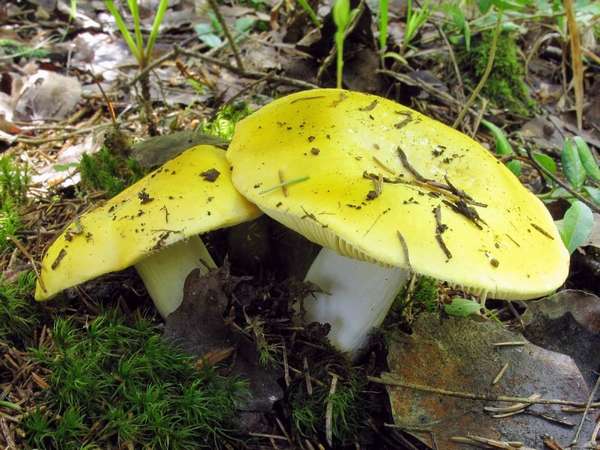
Brown russula (Russula xerampelina)
It has a violet color that is darker in the middle with a slightly convex or slightly concave shape with an impression in the center. It tastes good, but the smell is specific. Brown russula is named so due to the fact that if the leg is damaged, its color becomes brown from a reddish tint, unlike other counterparts, the color of which, when broken, remains the same color or turns a little gray. Interestingly, russula russula is considered a delicacy in some countries.
Blue russula (Russula azurea)
Mushroom with a semicircular to concave cap with an impression in the center of a delicate lilac to amethyst-blue color with a well-removable spider-skin. Has a pleasant aromatic taste.

Description of the appearance of the blue russula
The diameter of the cap of the azure russula is 5-8 centimeters. The cap is fleshy in structure. Its shape is initially convex, eventually becomes flat, and depressed in the center. The color of the cap is dark purple, amethyst blue, and sometimes olive blue and lilac. The central part of the cap is darker and its margins are lighter. The skin is easily separated from the cap.

The pulp is quite strong, white, not pungent. The pulp has no smell. Plates are straight, most often forked-branched, white. The spores are practically spherical, warty, or spiny. Spore white powder.
The leg is solid, tapering at the top. In young fruiting bodies, the legs are strong, and with age they become hollow and multi-chambered. The leg height ranges from 3 to 5 centimeters. The color of the leg is white.
Places of growth of azure russula
Blue russula grow in coniferous forests. They are found mainly in spruce forests. They live in whole nests. These mushrooms are common in the European part of our country and in the Baltic States. Azure russula bear fruit from August to September.


